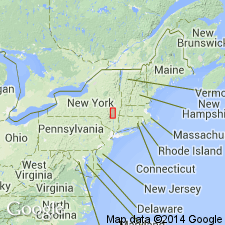
- Usage in publication:
-
- Dave Elliott Bed
- Modifications:
-
- Named
- Dominant lithology:
-
- Sandstone
- Shale
- AAPG geologic province:
-
- Appalachian basin
Summary:
Name Dave Elliott Bed is here proposed for a fossiliferous unit generally lying 13 to 15 m below the top of the Berne Member of the Mount Marion Formation (Hamilton Group) in eastern NY. Bed is typically a buff-weathering, fine to medium-grained, highly burrowed or bioturbated sandstone up to 1.5 m thick. At the southern end of the study area near Kingston, bed is a rusty-weathering silty shale up to 1.0 m thick, where brachiopods are the typical fauna. Fauna changes northward to include rugose corals and sandstone thickens. Sedimentary structures, for the most part, have been destroyed by burrowing. Bed is sometimes underlain by a horizon of bulbous to elongate nodules. Dave Elliott is one of four beds named in this report; the other three (Halihan Hill, Katsbaan, and Timmerman Hill) occur in the overlying Otsego Member, also of the Mount Marion. Age is Middle Devonian.
Source: GNU records (USGS DDS-6; Reston GNULEX).
For more information, please contact Nancy Stamm, Geologic Names Committee Secretary.
Asterisk (*) indicates published by U.S. Geological Survey authors.
"No current usage" (†) implies that a name has been abandoned or has fallen into disuse. Former usage and, if known, replacement name given in parentheses ( ).
Slash (/) indicates name conflicts with nomenclatural guidelines (CSN, 1933; ACSN, 1961, 1970; NACSN, 1983, 2005, 2021). May be explained within brackets ([ ]).

